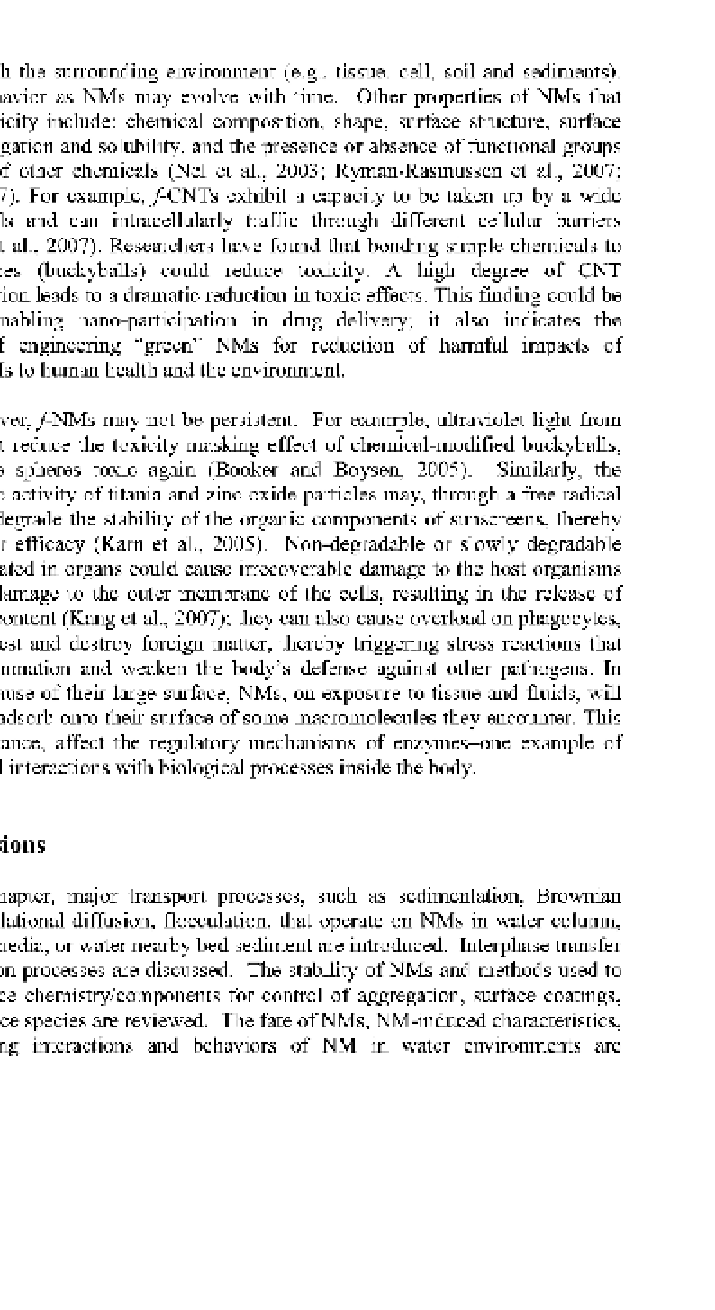Environmental Engineering Reference
In-Depth Information
reactivity with the surrounding environment (e.g., tissue, cell, soil and sediments),
and their behavior as NMs may evolve with time. Other properties of NMs that
influence toxicity include: chemical composition, shape, surface structure, surface
charge, aggregation and solubility, and the presence or absence of functional groups
or coatings of other chemicals (Nel et al., 2003; Ryman-Rasmussen et al., 2007;
USEPA, 2007). For example, ^CNTs exhibit a capacity to be taken up by a wide
range of cells and can intracellularly traffic through different cellular barriers
(Kostarelos et al., 2007). Researchers have found that bonding simple chemicals to
carbon spheres (buckyballs) could reduce toxicity. A high degree of CNT
functionalization leads to a dramatic reduction in toxic effects. This finding could be
helpful in enabling nano-participation in drug delivery; it also indicates the
possibility of engineering "green" NMs for reduction of harmful impacts of
emerging NMs to human health and the environment.
However, ^NMs may not be persistent. For example, ultraviolet light from
the sun might reduce the toxicity masking effect of chemical-modified buckyballs,
rendering the spheres toxic again (Booker and Boysen, 2005). Similarly, the
photocatalytic activity of titania and zinc oxide particles may, through a free radical
mechanism, degrade the stability of the organic components of sunscreens, thereby
reducing their efficacy (Karn et al., 2005). Non-degradable or slowly degradable
NPs accumulated in organs could cause irrecoverable damage to the host organisms
by physical damage to the outer membrane of the cells, resulting in the release of
intracellular content (Kang et al., 2007); they can also cause overload on phagocytes,
cells that ingest and destroy foreign matter, thereby triggering stress reactions that
lead to inflammation and weaken the body's defense against other pathogens. In
addition, because of their large surface, NMs, on exposure to tissue and fluids, will
immediately adsorb onto their surface of some macromolecules they encounter. This
may, for instance, affect the regulatory mechanisms of enzymes-one example of
their potential interactions with biological processes inside the body.
15.6 Conclusions
In this chapter, major transport processes, such as sedimentation, Brownian
motion and translational diffusion, flocculation, that operate on NMs in water column,
water in porous media, or water nearby bed sediment are introduced. Interphase transfer
and transformation processes are discussed. The stability of NMs and methods used to
manipulate surface chemistry/components for control of aggregation, surface coatings,
and bonded surface species are reviewed. The fate of NMs, NM-induced characteristics,
and corresponding interactions and behaviors of NM in water environments are

Search WWH ::

Custom Search